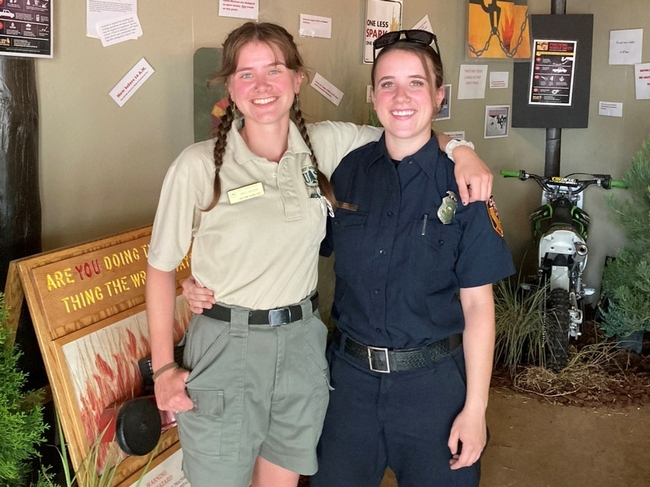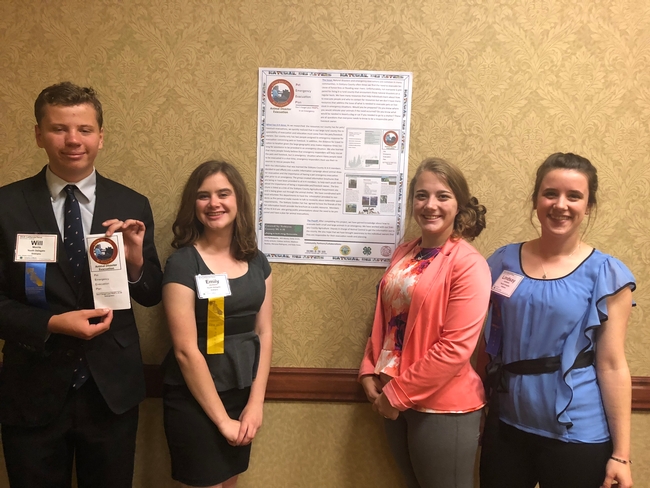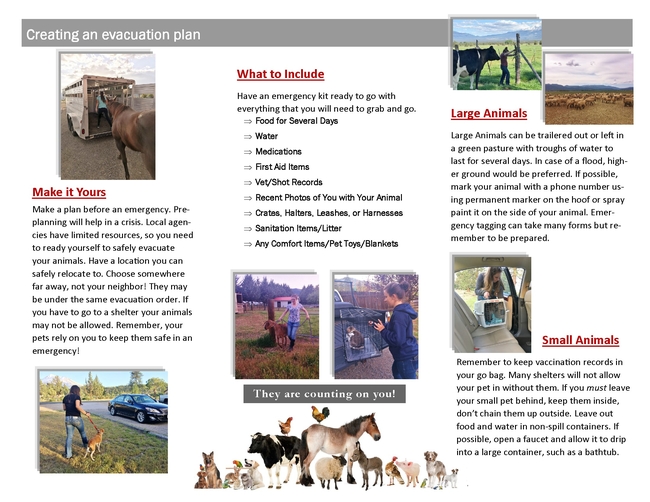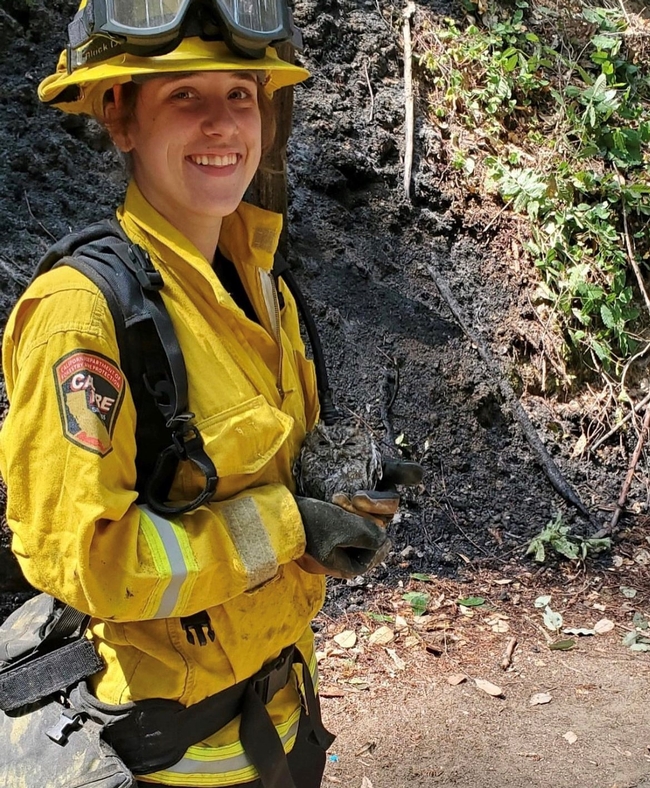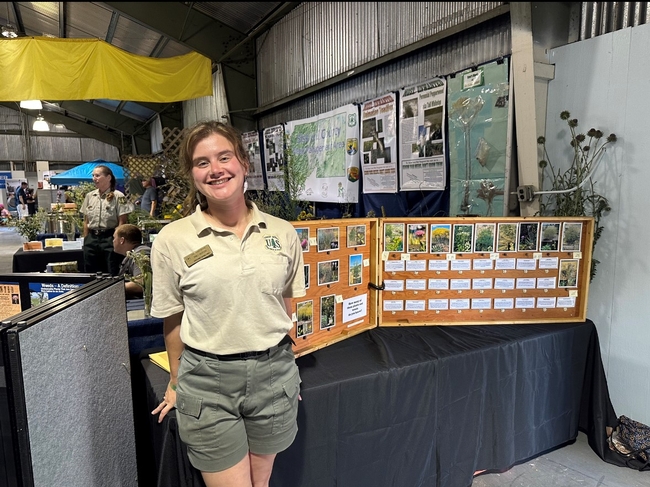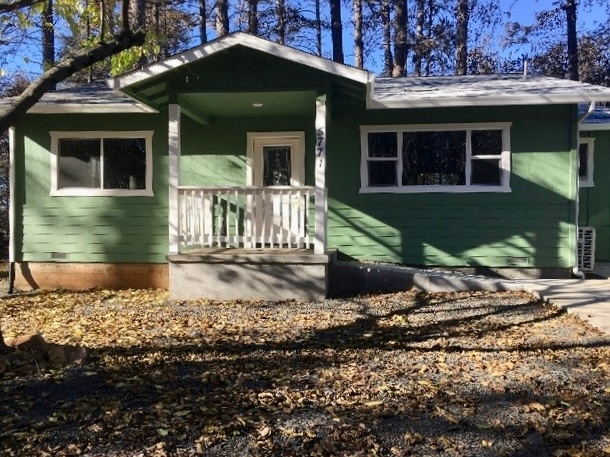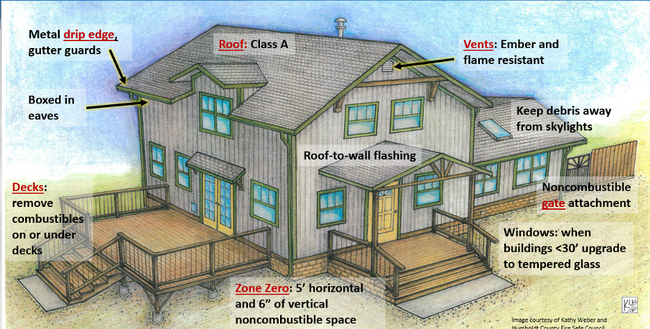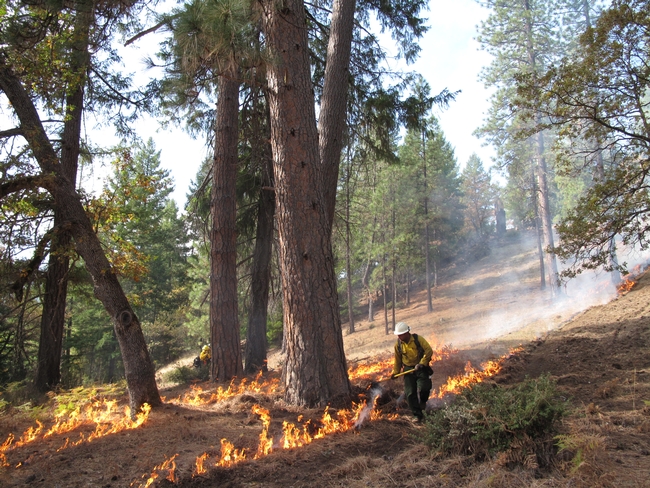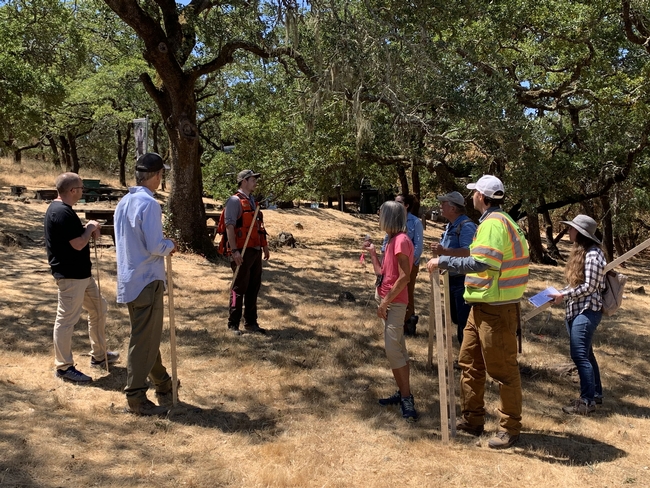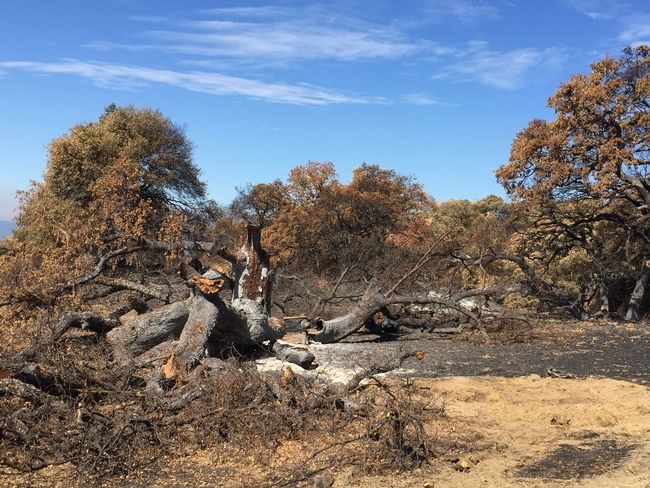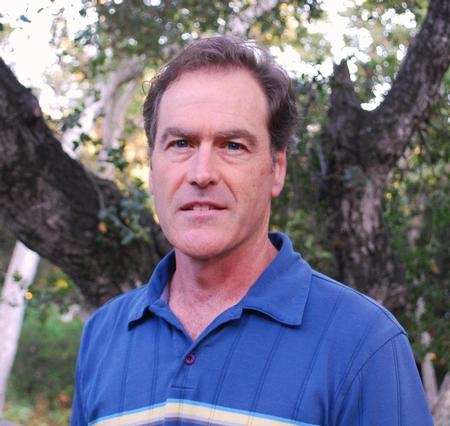Posts Tagged: Wildfire
4-H youth project helps Siskiyou County prepare animals for emergencies
Planning brochure for pets, livestock fills crucial need as fires an increasing threat
With the McKinney Fire creeping closer to Yreka in the summer of 2022, Emily Jackson and her mother potentially faced the enormous task of getting all their goats, chickens, dogs and cats to safety – while Emily's father and twin sister Lindsay were away fighting the fires.
Fortunately, Emily and Lindsay had gained crucial knowledge about evacuating animals through a 4-H service-learning project they helped lead in 2018. A group of eight 4-H youths, ages 14 to 18, had created a “Pet Emergency Evacuation Plan” (PEEP) brochure, aimed at educating their neighbors in Siskiyou County about the necessary preparations for livestock and pets.
The brochure, available through the Siskiyou County website, remains in use today in this densely forested region that saw another spate of wildfires this summer. The PEEP project team was composed of Kylie Daws, Emily Jackson, Lindsay Jackson, Will Morris, Madison Restine, Maryssa Rodriguez, Emily Smith and Callahan Zediker.
Within those stressful hours in 2022 when the McKinney Fire prompted an evacuation warning during which residents could be required to leave at any moment, Emily Jackson said she and her mother had a game plan in place – thanks to her work on the PEEP project.
“At the time, it wasn't even on my mind,” Jackson said, “but looking back now, I know that having the experience from making that brochure was driving my thought process at the time.”
And while the Jackson family and their neighbors ultimately were not asked to evacuate in 2022, many community members have benefited from the hundreds of copies of the PEEP brochure in circulation, which prompts residents to at least think about what their animals would need in an emergency, Jackson said.
Pet and livestock evacuation tips were needed
Such a resource previously had not been available among the county's emergency preparation materials, according to Jacki Zediker, the 4-H regional program coordinator in Siskiyou County who advised the PEEP project group.
“One piece that was missing was how to help our communities understand that when they evacuate, and they take their pets with them…it's not as simple as just taking their pets with them,” said Zediker, citing the example that some shelters do not take in animals – or do not take animals without proof of vaccination.
Other items to add to the pet's emergency kit include food for several days, water, medications, comfort items or toys, and recent photos of the owner with their animal (proof of ownership).
Zediker had connected the young people with Jodi Aceves, senior deputy agriculture commissioner/sealer for Siskiyou County, who had been overseeing the county's Animal Control programs and emergency response.
“There's a lot of information out there for people evacuating, but not necessarily for livestock and pets,” Aceves said. “Unfortunately, we have had some fires where there were lots of pets and livestock lost.”
She met several times with the 4-H group, discussing the county's evacuation systems and processes and the role of the Office of Emergency Services and law enforcement agencies, and sharing key considerations in preparing for emergencies – such as having a pre-agreement in place with someone who could house an evacuee's animals.
Aceves praised the teens for distilling the vital information into a short and simple brochure that community members could easily read and remember. She also was impressed by the energy and genuine care that the young people put into the project.
“Most of their lives, every summer, they've been in fire,” Aceves said. “It's close to their hearts, and they've seen a lot of their neighbors and other people in the county either affected by fire or evacuated at some point.”
For Lindsay Jackson, in particular, fire and serving the community have been lifelong passions, inspired by her father's work in the area.
“My dad was a volunteer fire chief for the South Yreka Fire Department; he was doing that since I was about two or three, so I grew up watching him go to the trainings, go to a call,” she explained. “When I was 15, I joined the fire department as a cadet to help out with the medical side, but the more I volunteered, I really liked the fire side, too.”
Jackson added that Zediker has a special knack for nurturing and encouraging the interests of the 4-H participants and applying them in a productive way.
“Jacki was really good at figuring out where our passions were and then how we could put our passions into a service-learning project,” she said. “She knew I was really big into fire and helping the community in that way since I was young.”
Zediker also helped the Jackson twins on their senior project, a fire-safety field day at the South Yreka fire station. More than 100 schoolchildren learned fire safety basics, met firefighters and emergency personnel, and heard about 4-H from Lindsay and Emily.
4-H experiences, mentorship inspire career paths
The PEEP project group also was asked by several organizations to share their knowledge about emergency preparations for animals. In addition to presenting a poster about their work at the 4-H California Focus conference in 2018, the group handed out the brochure and shared information at a table during a Juniper Flat Fire Safe Council workshop and resource fair.
Beyond distributing the PEEP brochure at 4-H club meetings, school events and community meetings, the youths have lent their voices to advocating for emergency resources for animals. Zediker noted that they contributed testimonials that helped the county acquire grants for purchasing more portable kennels.
But the most enduring impact of 4-H participation and community service, however, is that those experiences were a springboard for the young adults' careers. Emily Jackson – who participated in 4-H from age 5 to 19 – is now working toward a master's degree in biology at Cal Poly Humboldt, studying how fire suppression and other factors have changed plant communities in the Russian Wilderness.
Whether training colleagues as a U.S. Forest Service crew lead for the past couple of summers, or leading lab sections in general botany as a graduate student, Jackson said she draws on her 4-H experiences – and Zediker's inspirational example – as she pursues a career in teaching.
“In my development as a young adult into an adult now, I cannot overstate how big of a role Jacki played in that,” Jackson said.
Her sister Lindsay, meanwhile, has pursued her passion for fire all the way through the fire academy at College of the Siskiyous, where she also earned her emergency medical technician (EMT) license. Most recently working on fires near Pondosa in Siskiyou County, Jackson has been a seasonal firefighter based at the McCloud CAL FIRE station since 2020.
“It's hard because, in the last three years, I haven't left Siskiyou County, there's just been so many fires here,” she said. “But it's nice being able to help your community and know you're making a difference.”
Lindsay Jackson intends to pursue a bachelor's degree in leadership studies at Cal Poly Humboldt in hopes of getting a full-time position with CAL FIRE.
How can we navigate changes in the home insurance market?
A wildfire shockwave recently hit California. Maybe you missed it. While there were no large wildfires threatening homes, and the air wasn't thick with smoke like in the Northeast from the wildfires in Canada, a shockwave did hit.
State Farm, California's largest home insurance company, issued an emergency declaration. As I write this, I note that my homeowner's policy is with State Farm, and while this may not affect me today, it could affect me when I choose to sell my home or buy a new one.
State Farm announced they will stop issuing new home insurance policies. Allstate issued a similar policy last year. These actions, in essence, shrink the available pool of insurers in California and are a very troubling sign for all of us. Furthermore, this action may significantly lengthen the time it takes to sell or buy a home in California or may affect our long-term ability to sell in the future and capture the financial values we have in our properties.
The loss of over 43,000 structures to wildfire over the last 10 years has not gone unnoticed by the insurance industry. Increasing fire hazards and skyrocketing costs to rebuild has everyone on notice that business-as-usual is not working.
California's policymakers and the Insurance Commissioner have their hands full with structuring the insurance market, creating a market that manages risk and attracts a diversified pool of insurance carriers, stabilizing insurance availability and affordability, and supporting the real estate sector of California's economy.
As a member of the state's Risk Modeling Workgroup, I can tell you that many approaches are being debated to address our challenges, including 1) allowing reinsurance calculations to be a part of insurance rates, 2) finding other ways to fund the Fair Plan (California's insurance plan of last resort), and 3) allowing catastrophe models to forecast risk in order to better anticipate future losses. With the passage of Proposition 103 in 1988, rate setting has been driven by past claims experience. Most suggest that future losses are likely to be significantly worse than past losses.
On July 13, the California Insurance Commissioner will hold a public hearing on whether rates should utilize catastrophe models that can account for anticipated climate changes and risk mitigation actions taken by property owners. Further, the state's Risk Modeling Workgroup will issue a report on this topic later this summer.
While these approaches are nuanced and complicated to understand, there are many actions that property owners can take to protect the value of their properties and mitigate risks.
Given this period of insurance instability, the best action property owners can take is to understand and mitigate wildfire risks. Reducing fuels, improving defensible space, and hardening the exterior of their structures to heat, flame and ember exposures will help to entice insurance companies to underwrite your property, enhance the ability to sell the property, and improve the odds of the building surviving future wildfires. By marketing the value of these actions, just like the remodeled kitchen or other property upgrades that attract homebuyers, you can market your asset to future insurance companies and buyers. Proactive actions, like upgrading vents, are a key part of the solution.
AB 38 (2019) started this process by mandating that the seller of a property disclose to the future buyer defensible space actions that have occurred for properties in Very High and High Fire Hazard Severity Zones. In 2025, these disclosures need to include home hardening actions based on an established low-cost retrofit list. Over time, these actions are likely going to become key for the negotiation of price and potentially the closure of the sale.
Independent assessment of preventive actions may also be helpful. The Safer From Wildfires program was established in 2023 to help promote insurance discounts for the voluntary adoption of wildfire mitigation actions; in my opinion, it could be used as an insurability assessment as well. Another option is to consider the Insurance Institute for Business and Home Safety's Wildfire Prepared Home designation. Helping your community think through the issues and take collective action to meet a Firewise designation is another approach to consider.
More information about home hardening and defensible space can be found at UC Cooperative Extension's Fire website. And if you need help navigating a recent insurance cancellation, United Policyholders, a consumer rights advocacy organization, has helpful resources.
Wildfire adaptation will not occur overnight, but I believe we have a pathway and clear evidence to demonstrate that these types of specific actions will help all of us live successfully with wildfire in California now and into the future.
Prescribed fire, cultural burning get liability support to reduce wildfire risks in California
First-of-its-kind fund to offset losses if prescribed or cultural burn damages property
The State of California rolled out a first-of-its-kind approach to curbing the state's catastrophic wildfire problem on June 19 by providing new protections for prescribed fire and cultural burning practitioners. The $20 million allocated for the “Prescribed Fire Liability Claims Fund Pilot” will cover losses in the rare instance that a prescribed or cultural burn escapes control.
California Senator Bill Dodd authored the 2022 bill (Senate Bill 926) that made this fund possible, continuing his many years of leadership on wildfire and prescribed fire-related legislation.
“Prescribed fire is a cost-effective way to minimize the scope and severity of wildfires,” said Sen. Bill Dodd, D-Napa. “It's a tool that has been used for millennia by Native American tribes and one that will continue to play a big role in wildfire prevention. The rollout of this fund is a big step toward keeping California communities safe.”
The use of prescribed fire and cultural burning — sometimes collectively called “good” or “beneficial” fire — is a key component of wildfire risk management in California. These projects reduce hazardous fuels, help restore ecological and cultural values, and make our communities safer and our ecosystems more resilient to wildfire. However, lack of liability insurance for practitioners has been a major barrier to increasing the use of prescribed fire, even as firefighters, fire scientists, at-risk communities and state, federal and tribal leaders call for more.
The Prescribed Fire Claims Fund pilot project removes a significant barrier to obtaining insurance for potential damages from a prescribed fire or cultural burn conducted by a certified prescribed fire burn boss or a cultural fire practitioner,” said CAL FIRE Director/Chief Joe Tyler. “As we continue to focus on increasing the resiliency of the state's forests, creating a pathway for private burn bosses to have the significant protection this claims fund provides is a critical step toward reaching the goals of the Governor's Wildfire and Forest Resilience Action Plan.”
The fund will provide up to $2 million in coverage for prescribed fire projects led by a qualified burn boss or cultural practitioner. The fund is meant to demonstrate that prescribed fire, when carefully planned, resources and implemented, is a low-risk land management tool that mitigates the larger, more damaging risks of high-severity wildfires. The fund is the first of its kind nationally and is the result of several years of collaboration by a diversity of partners working with Senator Dodd's Office, including The Nature Conservancy, CAL FIRE, the University of California Cooperative Extension, the California Department of Insurance, tribal representatives and many others.
“Launching this program is a key step in scaling ecologically based forest management to reduce the risk of megafires. We appreciate Senator Dodd's leadership and the expedient work of CAL FIRE and beneficial fire practitioners to develop this fund as the next fire season quickly approaches,” said Dan Porter, The Nature Conservancy's Forest Program director.
The fund will also advance cultural burning, helping Indigenous Californians restore their connection to fire.
“Cultural burning is an essential practice to meet diverse objectives, including biodiversity stewardship, ecological health and community safety. The availability of this pilot fund provides cultural fire practitioners a safeguard against financial risk in the unlikely event of an escaped burn. This is a significant incentive to support revitalization of burning traditions following the legacy of policies banning such practices,” said Don Hankins, professor of geography and planning at CSU Chico and co-founder of the Indigenous Stewardship Network.
This fund is part of a larger vision for restoring beneficial fire across California's fire-adapted ecosystems. Last year, the state released its Strategic Plan for Expanding the Use of Beneficial Fire, which identified this claims fund as a priority. The state has also rolled out a state-certified burn boss program, changed the liability standard for prescribed fire, and made investments in prescribed burn associations, agency staffing, and other related efforts.
“We are using every tool to protect Californians, including using prescribed fire to fight wildfires,” said Insurance Commissioner Ricardo Lara. “The Prescribed Fire Claims fund will be critical to assisting our tribal groups, nonprofits and private landowners who are leading the way. This is an example of government being innovative and leading by example. The data that we get from the claims fund is going to be essential to our on-going education with insurance companies to support insuring this important work.”
Lenya Quinn-Davidson, Fire Network director for the University of California Agriculture and Natural Resources, says the recent momentum is unparalleled.
“Californians are desperate to have a better relationship with fire, and only with innovative approaches like this claims fund will we be able to unleash the good work that needs to happen,” said Quinn-Davidson. “It's a challenging time to be working on fire in California, but also an incredibly inspiring time.”
More information about the Pilot Prescribed Fire Claims Fund can be found on the CAL FIRE Website at https://www.fire.ca.gov/what-we-do/natural-resource-management/prescribed-fire, including frequently asked questions and an enrollment form for practitioners.
Workshops for forest landowners come to Solano, Sacramento counties, beginning July 18
Free forester site visit for landowners who complete workshop series
Forest landowners in Solano and Sacramento counties are encouraged to learn about their forests and connect with natural resource professionals in their areas during the next Forest Stewardship Workshop Series from University of California Cooperative Extension, July 18 to Sept. 12. These programs can be essential for small landowners who seek to make their forests resilient against wildfire.
Upon completing the nine-week series of virtual and in-person sessions, landowners also will be eligible for a free site visit from a local Registered Professional Forester (RPF), Certified Range Manager or California Certified Burn Boss.
Content is applicable to all forest landowners regardless of where their forest is located and will highlight talks from the local Resource Conservation District, UCCE forestry advisors, CAL FIRE, Natural Resources Conservation Service, and other natural resources community leaders. Registration fee is $60 for the workshop series, which will address common concerns among California landowners, including but not limited to:
- Forest ecology and vegetation management
- Financial planning and cost-sharing opportunities
- Oak woodland management and targeted grazing
Past participants have rated the workshop series highly, with 98% of 2022 participants rating the series overall as excellent or very good. In addition, 94% of past participants reported greater awareness of applying for and using cost-sharing programs.
A past participant has described the workshops as very accessible, saying “they (UCCE) broke things down into small pieces, [and] staff were always an email away.” In seeking to make an otherwise large amount of content approachable, UCCE hopes that landowners come away with a holistic understanding of the management process.
The workshop will take place in a hybrid setting, with classes taking place weekly online over Zoom. Participants will also engage in practical learning through a field day, where they can meet other cohort members and UCCE professionals at an outdoor field location.
At the conclusion of the workshop series, landowners will be equipped with the knowledge and network that will empower them to manage their forests in ways that meet their specific goals and objectives.
Community members in Sacramento and Solano counties interested in forest management, forest and fire ecology, and related topics are encouraged to register: https://surveys.ucanr.edu/survey.cfm?surveynumber=28675.
Forest landowners across California can learn about upcoming workshops in their areas, and also find additional resources, publications and videos: https://ucanr.edu/sites/forestry/Stewardship/.
Wildfires may spur animal biodiversity
Naturally fire-prone ecosystems tend to have more species of birds and mammals, new study reveals
Wildfires. Many see them as purely destructive forces, disasters that blaze through a landscape, charring everything in their paths. But a study published in the journal Ecology Letters reminds us that wildfires are also generative forces, spurring biodiversity in their wakes.
“There's a fair amount of biodiversity research on fire and plants,” said Max Moritz, a UC Cooperative Extension wildfire specialist who is based at UC Santa Barbara's Bren School of Environmental Science & Management and the study's lead author. Research has shown that in ecosystems where fire is a natural and regular occurrence, there can be more species of plants — a greater “species richness” — due to a variety of factors, including fire-related adaptations. But, he said, there hasn't been nearly as much research in the way of animal biodiversity and fire.
“If you look at how fire operates across the planet, fire actually eats plant productivity,” Moritz said. Productivity, which is a measure of how quickly biomass is generated within a given ecosystem, is also a driver of species richness at broad spatial scales. “When fires occur, they can take a bite out of that bottom line,” he added.
If fire regularly consumes some of the base of an ecosystem's food chain, how does that ripple up to affect the biodiversity at higher levels?
That was the question Moritz investigated during a project supported by UC Santa Barbara's National Center for Ecological Analysis & Synthesis; he later recruited collaborators Enric Batllori from Universitat de Barcelona and Benjamin M. Bolker from McMaster University in Canada. For several years they combed through global datasets on various factors such as plant biomass, fire observations and species richness patterns.
While it might be natural to assume that plant biomass regularly consumed by fire would in turn lead to lower animal biodiversity, they found that for birds and mammals, fire is associated with increased diversity. In fact, they say, the effect of fire on biodiversity in the case of birds rivals that of the ecosystem's productivity. And in the case of mammals, fire's influence was even stronger than that of productivity.
“It's counterintuitive,” Moritz said. In the short term, fire's consumption of plant material (also known as “net primary productivity”) could result in less food for the animals that consume plants and make it more difficult to survive and reproduce. But in the longer term, he said, there may be evolutionary effects that unleash adaptations and formations of new species.
The researchers also looked at the effect of fire on amphibian species, however, the connection between fire and biodiversity in their case was difficult to make, possibly because amphibians live in wetter environments where fires may not be a regular occurrence.
So what accounts for the net positive effects of fire on mammal and bird diversity? The study is a correlative one, Moritz said, so more granular examinations have to be made to find out for sure. But it's likely that fire selects for species that can adapt to and quickly recover from a burn, and fire often creates environmentally complex habitats that meet different species' requirements.
“We know that fire creates a lot of heterogeneity and opens up all these niches,” Moritz said, and this resource availability might create favorable environments for some organisms to flourish alongside or over others. For example, animals that have strategies to survive fires or reproduce faster might do better in a fire-prone environment, as could those that make use of different habitats that emerge in the wake of a blaze.
Despite the connection between fire and species richness, the authors are careful to point out it does not mean fire is good for all ecosystems. In places where fire is not a natural occurrence, its presence “is more of a modern threat than an important process to maintain,” they said. And for places where fire is a natural part of the ecosystem, climate change-driven and intentional deforestation fires “may be quite different from natural fire regimes.”
Nevertheless, they say, these findings indicate that fire plays an underappreciated role in the generation of animal species richness and biodiversity conservation. Furthermore, the study adds nuance to the Latitudinal Biodiversity Gradient, a global pattern of terrestrial biodiversity in which the world's most biodiverse areas are located nearest to the equator, with levels of biodiversity generally decreasing toward the poles.
“This is a pattern that people have known for decades and have argued quite a bit about in terms of what drives it,” Moritz said. “And it turns out, it's hard to figure out. And it looks like fire plays a far more important role than we've ever really understood.”


